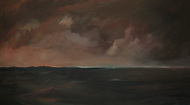
Horizon Event, by Anton SevcikIn a wonderful MASM (meeting of arts and science moment) a few weeks back, Anton (John) Sevcik - an old friend I had not seen in almost 16 - years had an art opening at the Fleisher Art Memorial in Phila. In his show Myth and Landscape, Anton displayed a number of paintings that featured a horizon as part of the story and inspiration for the piece, including one titled Horizon Event.
Anton has read and talked about physics for as long as I've known him. His work is often influenced by the ideas that affect him deeply. In Horizon Event, Anton conflates two ideas - The Event Horizon, and the Horizon Effect.
The event horizon is the boundary of a black hole, a region of space-time from which light cannot escape. Anything passing the horizon will vanish into oblivion.
The Horizon Effect arises from a non-physical situation. This effect is usually used to describe a situation where something that is out of sight - just beyond the horizon - is assumed to either be benign, or not exist. Often the horizon is not a physical one, but rather a demarcation point in a process. Artificial intelligence software, e.g., often suffers from the effect. Using look-ahead trees for decision making (as in, e.g. a chess program), the trees must be truncated at some point, possibly before revealing a fatal error about to occur.
Both event horizon and horizon effect then describe a knowledge/lack of knowledge interface. One is physically defined because of a singularity in spacetime, while the other arises from algorithmic expediency. In both cases there is tension at the boundary between information and chaos, knowledge and incoherence.
Anton's paintings, many of which are dark and brooding (just what is on the other side of that horizon?) suggest a cleft unbridgeable by science but traversable by canvas, oil, and artistic creation.
Anton/John has just started his own blog, View From the Studio, where you'll find more pictures from Myth and Landscape Show.